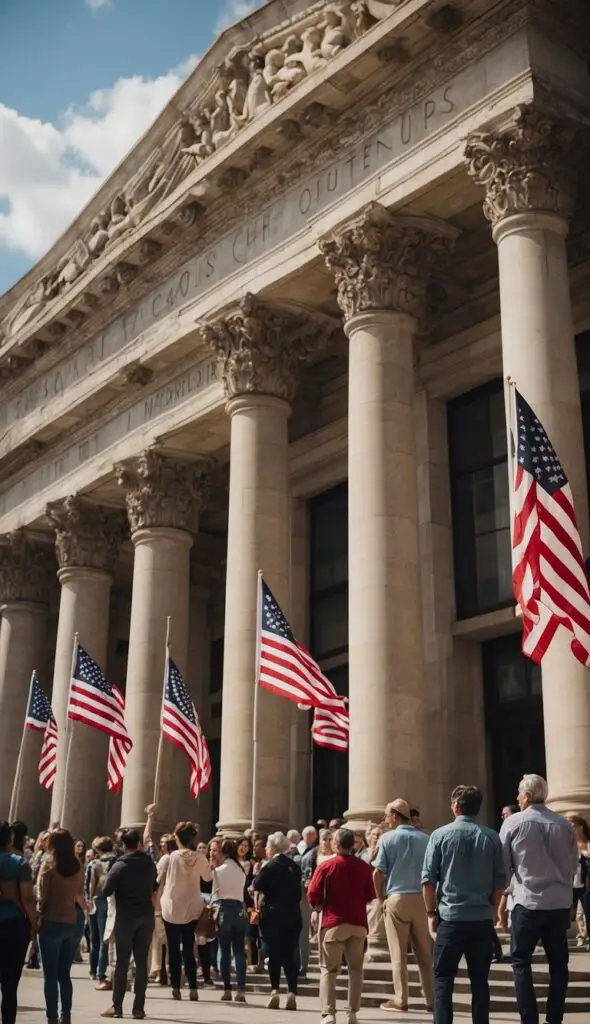The Museum of the American Revolution in Philadelphia offers a unique glimpse into the early days of American history. This captivating museum tells the story of the American Revolution with a rich collection of artifacts, immersive galleries, and interactive exhibits. Visitors will find compelling stories about the diverse people and events that shaped America’s fight for independence.

Located in Philadelphia’s Old City District, the museum is conveniently near other historic landmarks such as Independence Hall and the Liberty Bell. It opened to the public on April 19, 2017, aligning with the anniversary of the Battles of Lexington and Concord. By exploring the museum, visitors can experience powerful theater performances and educational programs that bring history to life.
Plan your visit to the Museum of the American Revolution for an educational and inspiring journey through America’s past. From unique artifacts to engaging exhibits, there is something for everyone to discover and appreciate.
Key Takeaways
- The museum provides a detailed look at the American Revolution.
- Located in Philadelphia’s historic district, it’s near key landmarks.
- Offers artifacts, immersive galleries, and interactive exhibits.
The Foundation of the Museum
The Museum of the American Revolution is built on a clear mission, guided by dedicated leadership, and committed to sustainability. Each of these elements is vital to its operation and success.
Mission and Vision
The museum aims to tell the comprehensive story of the American Revolution. Its mission focuses on educating the public about the diverse people and events that were pivotal in shaping the nation. The museum’s vision looks forward to expanding its influence and engagement through various initiatives.
By 2026, the museum intends to reach more people and have a broader impact as the nation prepares to celebrate 250 years since its founding. This vision is coupled with efforts to enhance visitor experiences through immersive exhibits and educational programs.
Leadership and Board of Directors
Leadership at the museum consists of an experienced team dedicated to its mission. The Board of Directors plays a crucial role in governance, ensuring the museum adheres to its goals and values.
The board includes professionals and enthusiasts who bring a wealth of knowledge and expertise. Their commitment helps steer the museum towards achieving its strategic goals, including the expansion of its collection and outreach programs.
Sustainability Commitments
Sustainability is a core aspect of the museum’s operations. Efforts include the use of eco-friendly materials and practices in exhibits and daily operations. The museum seeks to minimize its environmental footprint through energy-efficient systems and sustainable sourcing of materials.
Furthermore, the museum engages visitors in understanding historical and contemporary perspectives on sustainability. Programs and exhibits often highlight the balance between preserving history and protecting the environment for future generations.
Exploring the Galleries

The Museum of the American Revolution offers a rich array of galleries and exhibits that take visitors back to the time of America’s birth. Each section offers unique insights into the lives of the people and the events that shaped the nation.
Permanent Exhibits
The permanent exhibits at the Museum of the American Revolution showcase artifacts, documents, and artwork that illustrate the story of the American Revolution. These galleries cover the entire conflict, starting from the early stirrings of rebellion to the Treaty of Paris. Key items include the first printed versions of the Declaration of Independence and an authentic Continental Army uniform.
Visitors can explore interactive displays that explain the diverse perspectives of the groups involved, such as Loyalists, Patriots, and Native Americans. The exhibits also highlight the significant battles and strategies employed throughout the war. Through a combination of multimedia presentations and authentic artifacts, the museum ensures that the key moments and daily realities of the Revolutionary War are brought to life.
Special Exhibitions
Special exhibitions at the Museum of the American Revolution rotate periodically, providing fresh insights and perspectives on various aspects of the American Revolution and its legacy. Each special exhibition focuses on a unique theme, such as the role of women in the revolution or the international influence of the American fight for independence.
These exhibitions often feature rare artifacts and documents on loan from other institutions, offering visitors a chance to see items that are not part of the regular collection. Additionally, interactive elements and engaging narratives make these exhibitions particularly appealing to younger audiences and history enthusiasts alike. Information about current and upcoming special exhibitions is readily available on the museum’s website.
Washington’s War Tent
One of the standout features of the Museum of the American Revolution is George Washington’s War Tent. This iconic artifact, which served as Washington’s mobile headquarters during the Revolutionary War, is displayed in a dedicated theater. Accompanied by a dramatic presentation, the tent helps visitors appreciate the strategic and symbolic importance of Washington’s leadership.
The exhibit provides detailed information about the tent’s construction, use, and preservation. Visitors can learn about the challenges faced by Washington and his troops, and the role the tent played in key moments of the war. This exhibit serves as a powerful reminder of the resilience and determination that characterized America’s fight for independence.
Collections and Artifacts

The Museum of the American Revolution houses a vast array of artifacts and documents that provide a vivid picture of the Revolutionary War period. Visitors can explore these unique objects and learn about key moments and figures from America’s early history.
Revolutionary War Artifacts
The museum’s collection includes numerous artifacts from the Revolutionary War, showcasing items such as weapons, uniforms, and personal items of the soldiers. Noteworthy pieces include muskets, swords, and powder horns used in significant battles. These artifacts provide insight into the daily lives of soldiers and the strategies employed during the war.
One striking artifact is George Washington’s tent, which served as his mobile command center. The museum also features objects related to the Oneida Indian Nation, allies of the American forces. These pieces highlight the diverse participation in the fight for independence.
Historical Documents and Manuscripts
In addition to physical artifacts, the museum holds an impressive collection of historical documents and manuscripts. This collection includes letters, diaries, and printed works that shed light on the thoughts and experiences of those who lived through the Revolution.
A standout item is the original parchment of the Declaration of Independence. Visitors can also view letters written by key figures like John Adams and Thomas Jefferson. These documents offer personal insights into the challenges and triumphs of the Revolutionary period.
Printed works, such as newspapers from the era, help illustrate how information was disseminated and public opinion shaped. This collection provides a deeper understanding of the social and political landscape during the American Revolution.
Educational Programs and Events
The Museum of the American Revolution offers engaging educational programs and events to spark curiosity and foster a deeper understanding of America’s past. These activities include interactive learning experiences and vibrant reenactments, providing a hands-on approach to history.
Interactive Learning
The museum provides a variety of interactive learning opportunities that cater to all ages. Programs like the Finding Freedom Interactive explore the stories of African American men and women during the American Revolution, allowing visitors to connect with the past in a meaningful way.
Students and educators can take advantage of in-person sessions as well as resources available online for homeschooling. The museum also offers a rich collection of archived videos, such as the Read the Revolution Speaker Series, which can be accessed from home. These interactive experiences aim to make history accessible and engaging.
Reenactments and Special Events
The Museum of the American Revolution hosts dynamic reenactments and special events throughout the year. Live demonstrations, performances, and holiday weekends bring history to life. These events often feature costumed interpreters who recreate key moments and daily life from the Revolutionary era.
For those who love immersive experiences, the museum includes reenactments of pivotal battles and significant historical events. These activities provide both an educational and entertaining way to connect with America’s founding story.
Special exhibits and themed weekends also offer unique insights and a chance to participate in hands-on history. These events are designed to deepen visitors’ appreciation and knowledge of the American Revolution.
Supporting the Museum
Supporting the Museum of the American Revolution can be done through memberships, volunteer work, and donations. Each method helps in unique ways, benefiting both the contributors and the institution.
Membership Information
Membership at the Museum of the American Revolution offers multiple benefits. Members receive a welcome packet with a printed membership card and a Member Guide. They also get a member decal, plus invitations to special events, lectures, and receptions. Furthermore, members have first looks at exhibitions, ensuring they stay ahead in knowing what’s new.
Members also enjoy notable discounts. This includes a 10% discount at the Museum Shop and a 15% discount at the Cross Keys Café. Additionally, discounts are available on both onsite and virtual public programs, making it easier to engage with the museum’s offerings. Membership helps support the museum’s mission and provides unique experiences and savings.
Volunteer Opportunities
Volunteering at the museum offers an enriching experience for those passionate about history. Volunteers can engage in various roles, from guiding tours to assisting with special events. There are opportunities to help in educational programs, providing a chance to interact with school groups and families.
The museum values its volunteers and often provides training sessions to help them gain deeper knowledge about the American Revolution. This paves the way for a more engaging and accurate portrayal of history. Volunteering not only supports the museum but also helps individuals connect with others who share a passion for history and education.
Donations
Donations play a crucial role in the museum’s sustainability. Contributions provide general operating support, aiding in the creation and maintenance of virtual exhibitions, events, and educational programs. This support helps the museum keep the community engaged and active, ensuring that the stories of the American Revolution remain accessible to all.
There are several ways to donate. One can make a one-time gift or choose to provide ongoing support through recurring donations. Donors can also explore the option of contributing to specific programs or exhibitions. Such financial support is essential to preserve the museum’s artifacts, host meaningful events, and offer educational experiences to visitors of all ages.
Visitor Information
Visitors planning a trip to the Museum of the American Revolution in Philadelphia will find details about ticket prices, directions, parking, and accessibility options. These specifics will help make your visit seamless and enjoyable.
Tickets and Pricing
The Museum offers a variety of ticket options. Adult tickets are priced at $21, while seniors (65+ years) can access the museum for $18. Youth tickets, for ages 6-17, cost $13. Children under 6 can visit for free. There are also discounts for military personnel and teachers.
Group rates are available for parties of 15 or more. They offer a guided tour that comes with a small additional fee. To avoid long lines, it is advisable to purchase tickets online in advance.
Directions and Parking
The Museum is located at 101 South Third Street, Philadelphia, PA 19106. It’s conveniently positioned in the Old City District. This is a historic area, near prominent landmarks such as Independence Hall and the Liberty Bell.
Several parking garages and street parking options are available nearby. Penn’s Landing and the Delaware River waterfront also offer additional parking. Visitors using public transportation can take the SEPTA trains or buses, which stop close to the museum.
Accessibility
The Museum of the American Revolution ensures accessibility for all visitors. Their facilities are ADA compliant. Elevators, ramps, and wide doorways make it easy for wheelchair users to navigate the museum.
Assistive listening devices, tactile tours, and large print guides are available upon request. Service animals are welcome throughout the museum. They also provide accessible restrooms and designated parking spaces close to the entrance to meet the needs of all guests.
Online Features
The Museum of the American Revolution offers various online features that bring history to life. These include a virtual museum tour, extensive digital collections, and a range of educational resources, making it easier for everyone to explore and learn about the American Revolution.
Virtual Museum Tour
The Virtual Museum Tour allows visitors to explore the Museum of the American Revolution from home. Partnered with Scholastic and author Lauren Tarshis, this tour includes 360-degree panoramic images, high-resolution images of artifacts, and a guided audio tour.
It offers an immersive experience, allowing users to navigate through the museum’s exhibits and gain insights into the nation’s founding. This online feature makes it possible for individuals worldwide to enjoy the museum’s offerings without traveling.
Digital Collections
The Museum boasts an extensive digital collection that showcases a wide range of artifacts from the American Revolution. Visitors can access high-resolution images of objects, manuscripts, maps, and artworks.
This online archive allows users to closely examine items like George Washington’s tent or a rare copy of the Declaration of Independence. The digital collections provide a valuable resource for researchers, students, and history enthusiasts seeking an in-depth look at the artifacts and documents that shaped the United States.
Educational Resources
The Museum offers comprehensive educational resources designed to help teachers, students, and learners of all ages. These include lesson plans, interactive activities, and virtual field trips.
Materials are often created in partnership with Scholastic and align with educational standards. The resources are crafted to engage students and provide a deeper understanding of the people and events of the American Revolution.
This makes it easier for educators to integrate rich, historical content into their curriculum and offers students an interactive way to learn about American history.
The Role of Individuals

Individuals played crucial roles in the American Revolution, from leading the fight for independence to contributing through diverse perspectives. Their actions shaped the course of history.
Influential Leaders
Key leaders were essential in guiding the American Revolution. George Washington, as the Commander-in-Chief, led the Continental Army to crucial victories. His leadership skills were evident during the winter at Valley Forge, where he kept the army together through difficult conditions.
Thomas Jefferson’s role was significant as he authored the Declaration of Independence. His writings articulated the colonies’ desire for freedom and inspired many to join the cause. Benjamin Franklin, a diplomat, secured vital support from France, which was instrumental in achieving independence. Their combined efforts proved decisive in the struggle for liberty.
Women in the Revolution
Women contributed significantly, though often overlooked. They managed homes and businesses in the absence of men. Some like Abigail Adams advocated for women’s rights, reminding leaders to consider women in new laws.
Many served as spies, gathering crucial intelligence. Anna Strong is known for her role in the Culper Spy Ring, helping to relay information about British troop movements. Others, like Molly Pitcher, took part in battle, providing water to soldiers and even manning cannons. Their involvement was vital to supporting military efforts and maintaining the home front.
Native American Contributions
Native Americans had diverse roles and perspectives during the revolution. Some tribes sided with the British, hoping to protect their lands from colonial encroachment. The Iroquois Confederacy saw internal divisions as different nations supported different sides.
Others, like the Oneida, allied with the American colonists, providing essential support in battles. Native Americans also offered knowledge of the land, aiding in strategic planning. Their contributions, although complex and varied, had a significant impact on the dynamics of the war.
The American Revolution
The American Revolution was a pivotal period in history that reshaped perspectives on freedom, governance, and human rights. It involved key battles, influential leaders, and the struggle for liberty against British rule.
Key Historical Moments
The American Revolution saw many crucial events. The Battles of Lexington and Concord on April 19, 1775, marked the war’s beginning. This was followed by the Battle for New York in 1776, where British forces attempted to take control of the colonies’ pivotal city.
In 1777, the harsh Winter at Valley Forge tested the resolve of the Continental Army. Under General George Washington’s leadership, the troops endured extreme conditions, emerging stronger. The signing of the Declaration of Independence on July 4, 1776, formalized the colonies’ break from Britain.
Life During the Revolution
Life during the American Revolution was hard for many. Soldiers faced harsh winters and shortages, particularly during the March to Valley Forge. Civilians, too, faced difficulties, such as food and supply shortages. Women played vital roles, managing homes and farms, and sometimes even acting as messengers or spies.
In Philadelphia, the Independence Hall was the hub for revolutionary activities. It was here that the Declaration of Independence was debated and adopted. Daily existence involved balancing the struggle for liberty with the harsh realities of war.
Struggle for Independence
The struggle for independence involved both military actions and ideological battles. Leaders like George Washington were pivotal. Washington’s leadership during the difficult winter at Valley Forge was crucial. Soldiers’ sacrifices and perseverance were vital in sustaining the fight against a powerful British army.
Intellectual efforts also played a significant role. The Declaration of Independence laid out the colonies’ reasons for seeking independence and their vision of a new nation built on principles of liberty. This document was a bold claim for self-governance.
The combination of military resilience and visionary leadership ultimately led to victory and the establishment of the United States of America.
The Legacy of Freedom

The Legacy of Freedom at the Museum of the American Revolution reflects the journey of the nation towards liberty, equality, and self-governance. It captures the challenges faced by the new republic and the formation of the Constitution, highlighting the lasting impact on the country’s politics and society.
Formation of a New Republic
After the American Revolution, the new nation faced numerous challenges in establishing a stable government. General George Washington, serving as the first Commander-in-Chief, played a crucial role in leading the country through its darkest hours.
Debates over the structure of the new republic were intense. Loyalists who had sided with Great Britain often met fierce opposition from those who sought liberty and equality. The Liberty Tree, once a symbol of resistance, became a metaphor for the growing pains of a nascent republic.
Politics during this period were highly charged, with various factions vying for influence. The initial framework for governance was established, though it was clear that more comprehensive guidelines were needed to ensure the nation’s longevity.
Constructing the Constitution
Constructing the Constitution was a process marked by intense debates and significant compromises. Delegates gathered to draft a document that would serve as the foundation of the new republic.
One of the foremost challenges was balancing the need for a strong central government with the desire to protect individual liberties. Equal representation for the states, regardless of size, was a key issue that sparked considerable discussion.
The Bill of Rights was later added to safeguard freedoms such as speech, religion, and assembly, addressing fears that the new government might replicate the tyranny of Great Britain. These amendments provided a framework for ensuring liberty and equality.
Throughout these discussions, the influence of prominent leaders like General Washington was evident. Their vision and commitment to building a strong yet flexible Constitution were instrumental in shaping the political landscape of the fledgling nation.
Planning Your Visit

Visitors to the Museum of the American Revolution can expect a well-structured experience, from understanding the operating hours to making group reservations. The museum offers various amenities to ensure a rich and enjoyable visit.
Operating Hours
The Museum of the American Revolution is open daily from 10 a.m. to 5 p.m. Visitors should note that the museum is closed on Thanksgiving Day, Christmas Day, and New Year’s Day.
The Cross Keys Café, located within the museum, operates daily from 10 a.m. to 4:30 p.m. This café provides a convenient spot for guests to enjoy refreshments during their visit. The Museum Shop is open during the museum’s operating hours and offers a variety of books, gifts, and apparel suitable for all ages.
Tickets can be purchased online or at the museum. It’s advisable to buy them in advance to avoid long queues, especially during peak seasons.
Group Reservations
Group reservations provide a tailored experience for visitors arriving in large numbers. The museum offers special rates for groups, making it an economical option for schools, organizations, or any large gathering.
To arrange a group visit, it’s necessary to contact the museum in advance. The reservation process is designed to accommodate the specific needs of each group, including guided tours that enrich the educational value of the visit.
Parking for buses and large vehicles is available near the museum, making logistics simpler for group organizers. Visitors driving to the museum will find ample parking spaces, though it’s a good idea to plan ahead for parking arrangements due to the museum’s central location in historic Philadelphia.
Additional Resources

The Museum of the American Revolution offers a variety of valuable resources for students, educators, professionals, and anyone interested in learning more about America’s past. These resources include detailed annual reports, strategic plans, career opportunities, and contact information for further inquiries.
Annual Reports and Strategic Plans
The Museum publishes annual reports to keep stakeholders informed about its progress and achievements. These reports cover financial performance, visitor statistics, and notable events from the year. The Museum also outlines its future goals in comprehensive strategic plans. These documents focus on expanding educational programs, increasing visitor engagement, and maintaining the institution’s financial health. Interested individuals can access these reports and plans to understand the Museum’s direction and effectiveness.
Career and Internship Opportunities
The Museum of the American Revolution offers a variety of career and internship opportunities. These positions range from curatorial roles to educational outreach, marketing, and guest services. Internships are often available for students and recent graduates, providing hands-on experience in museum operations. Full-time and part-time employment opportunities are regularly posted on the Museum’s website. These roles offer competitive salaries and benefits, contributing to a fulfilling career in the museum sector.
Contact Information
For more information or specific inquiries, visitors can reach out to the Museum through various contact options. The Museum’s website provides a comprehensive list of email addresses and phone numbers for different departments. Visitors can also send messages through an online contact form available on the website. Additionally, the Museum is located at 101 South Third Street, Philadelphia, PA, 19106, and is open from 10 am to 5 pm daily.
By offering these avenues for communication, the Museum ensures that all visitors can easily access the information they need.
Frequently Asked Questions

Visitors often have common queries regarding tickets, tours, events, management, time allocation, and virtual tour options at the Museum of the American Revolution.
How can one purchase tickets to the Museum of the American Revolution?
Tickets can be purchased online through the Museum’s official website, or on arrival at the main entrance. It is advisable to buy in advance to ensure entry, especially during peak times.
What types of tours are available at the Museum of the American Revolution?
The Museum offers both self-guided and guided tours. Guided tours provide a structured visit with detailed narratives by experienced docents. Self-guided tours allow visitors to explore at their own pace using provided maps and audio guides.
Can you list the types of events hosted by the Museum of the American Revolution?
The Museum hosts a variety of events, including lectures, workshops, reenactments, and educational programs. Special events also mark significant historical dates and public holidays, ensuring an engaging experience for all age groups.
Who is responsible for the operation and management of the Museum of the American Revolution?
The Museum is operated and managed by a dedicated team of historians, educators, and professionals. This team works under the guidance of the Museum’s board of directors to preserve and present the history of the American Revolution.
How much time should a visitor allocate for a full tour of the Museum of the American Revolution?
Visitors should allocate approximately 2 to 3 hours for a full tour. This allows ample time to explore the extensive exhibits, interactive elements, and immersive galleries that cover the key events and figures of the American Revolution.
Are there virtual tours available for the Museum of the American Revolution?
Yes, the Museum offers virtual tours through its online platform. These tours provide an accessible way to experience the exhibits and learn about the Revolutionary War from anywhere in the world.





